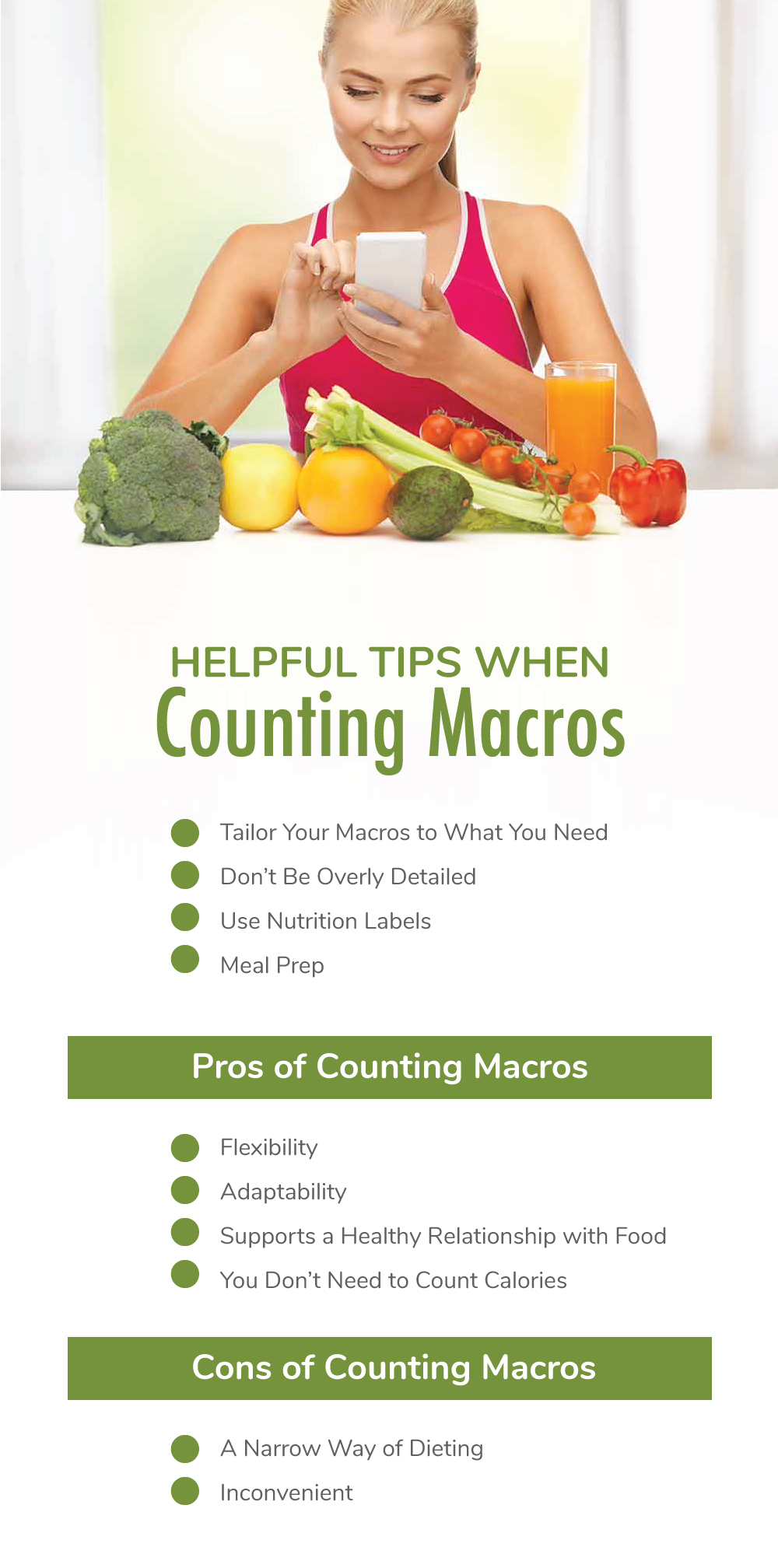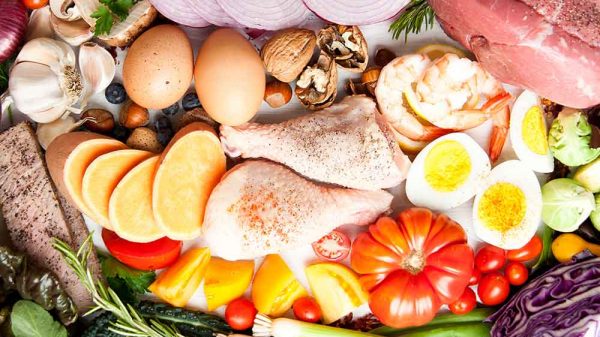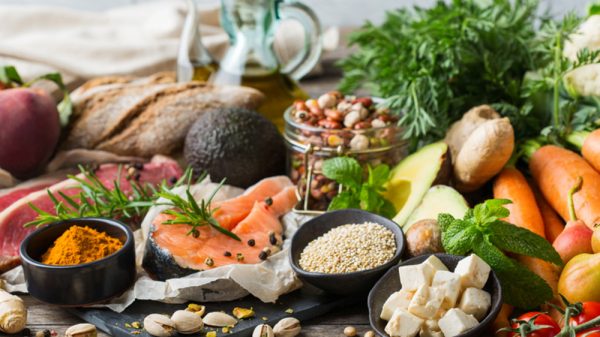Losing weight is often a critical part of the treatment plan for nonalcoholic fatty liver disease. There are countless diets and plans for weight loss – from counting calories and cutting carbs, to intermittent fasting and following a plant-based diet. One of the current trends hitting the fitness industry now is tracking macronutrients. But what are macros in food? Here we go through what it means to count macronutrients, and how this can help you lose weight and manage fatty liver disease.
What Are Macronutrients?
Macronutrients are the three main types of nutrients that provide the calories in our diets: fats, protein, and carbohydrates. All three macros are indispensable nutrients for healthy functioning yet differ significantly in structure.
Fat
Our bodies require dietary fat to function properly. Fats, in the form of cholesterol and lipids, comprise the cell membranes that provide structural support for all of our cells. Getting fat through the foods we eat is also essential for facilitating the absorption of vitamins A, D, E, and K. These vitamins are fat-soluble, meaning fat is the shuttle for these vitamins to make their way from the digestive system to the other areas in the body.
Fat is also essential for brain function, skin health, protecting organs from physical injury, and helping the body maintain its temperature.
Carbohydrates
Dietary carbohydrates provide fuel for the body. Carbohydrates are available in dietary sources in four different forms, depending on their chemical structure and composition. Most sugars found in fruits and added sugars are categorized as monosaccharides and disaccharides and are more simple forms of carbohydrates. Polysaccharides are found in the starchy parts of foods like potatoes, rice, bread, and pasta. Oligosaccharides can be found in plant foods like onions, beans, and asparagus.
When carbohydrates are consumed, the body breaks them down into glucose, which is then released into the bloodstream to create a rise in blood sugar. The body responds accordingly by releasing insulin, which signals the uptake of glucose into tissues throughout the body. All cells in your body then convert glucose into a useable form of energy called adenosine triphosphate (ATP), which powers all of the body’s activities.
Protein
Protein is vital to our health because it provides amino acids. Amino acids are the smallest units of proteins and are involved in nearly all biological processes. The body breaks down protein particles into individual amino acids that can then be recombined to make muscle tissue, neurotransmitters, hormones, enzymes, and other protein-based compounds. There are 20 amino acids that the body needs to survive, and we require the dietary intake of 9 amino acids. These nine amino acids are referred to as “essential,” because our body is unable to synthesize them on its own. The nine essential amino acids are histidine, threonine, methionine, lysine, leucine, isoleucine, valine, phenylalanine, and tryptophan.
Macronutrients vs Micronutrients
There are several significant differences between macronutrients and micronutrients. As is implied by the name, macronutrients are much larger molecules than are micronutrients. Micronutrients encompass the vitamins, minerals, fiber, and antioxidants in our food and don’t contribute to the caloric value of the foods we eat.
Despite the differences, both macros and micros are crucial for optimal health and work together synergistically to support healthy functioning. For example, the body handles sugar much more effectively when it is paired with fiber, as is the case in fruit. Fiber allows the digestive system to absorb sugar slowly, preventing spikes in blood sugar and promoting metabolic health.
Moreover, as discussed above, some vitamins are fat-soluble are best absorbed with eaten with dietary fats.
The Beginner’s Guide to Counting Macros
Counting macros means you measure the number of grams of fat, protein, and carbs that you consume in a day. The Office of Disease Prevention and Health Promotion recommends that an adult should get 10-35% of calories from protein, 45-65% from carbohydrates, and 20-35% from fat.
This is a fairly broad range, and exact percentages are determined by variations in dietary needs.
As an example, let’s determine that macronutrient levels for sedentary, 30-year-old male who requires about 2,400 calories per day and aims to get 25% of his calories from protein, 60% of his calories from carbohydrates, and 25% of his calories from fat. (2)
Using these percentages and applying them to the total calorie intake, we find that 600 calories should come from protein; 1,200 calories should come from carbohydrates; 600 calories should come from fat.
So, how do we convert these measurements to grams of macronutrients? It’s helpful to use the guideline that a gram of fat provides nine calories, and a gram of either carbohydrates or protein provides about four calories. (3)
So, in order to reach an intake of 600 calories from protein, the example individual must eat 150 grams of protein. In order to reach 1,200 calories from carbohydrates, he must consume 300 grams of carbohydrates. To reach 600 calories from fat, he must consume about 67 grams of fat.
Keep in mind that these serve only as an example of the process of determining macronutrients. Your individual macro requirements depend on your age, gender, and how much exercise you do.
Counting Macros for a Sample Meal
Let’s say for lunch, you have a peanut butter sandwich made with a tablespoon of peanut butter and two pieces of whole wheat bread; a banana; and nonfat Greek yogurt. Using a nutrition label or FoodData Central, you would find that two pieces of whole wheat bread afford 6 grams of protein, 4 grams of fat, and 28 grams of carbohydrates. (4)
One tablespoon of peanut butter provides about 3.5 grams of protein, 7 grams of fat, and 1.5 grams of carbohydrates. (5)
A banana provides about 1 gram of protein, 0.5 grams of fat, and 27 grams of carbohydrates. (6)
A nonfat Greek yogurt contains about 9 grams of protein, 0 grams of fat, and 11 grams of carbohydrates. (7)
Tallying up your macros would mean that your lunch provides 19 grams of protein, 11.5 grams of fat, and 67.5 grams of carbs that count towards your daily macronutrient total.
Helpful Tips When Counting Macros
1. Tailor Your Macros to What You Need
Make sure that your protein, carbohydrate, and fat content are tailored to your specific needs. Many macro-counting calculators are available online, as well as many tracking apps like MyFitnessPal and IIFYM (If It Fits Your Macros) that provide guidance for determining food macros. The U.S. Department of Agriculture also has a helpful portal called FoodData Central for looking up nutrition facts of different foods, including meal items at fast-food restaurants. (8)
In addition to the wealth of online resources, it’s also a good idea to also consult a nutritionist or fitness professional to ensure that your macros are ideal for your needs.
2. Don’t Be Overly Detailed
Don’t drive yourself crazy trying to measure fractions of grams. Just measure your portion as accurately as possible, and round to the nearest half of a gram to make it easier to add and calculate.
3. Use Nutrition Labels
Nutrition labels on the back of food products help to make counting macros easier. Just a quick tip when looking at nutrition labels on food products or online: You don’t need to combine the grams of carbohydrates and grams of sugar. The sugar is already included in the total carbohydrates.
4. Meal Prep
Meal-prepping is a time-saver when it comes to counting macros. For example, let’s say you make a large batch of brown rice and lentil soup for lunches throughout the week. If you pre-portion the servings, this means that you only need to go through the process of measuring the macros one time – during meal prep – which you can then apply to your daily totals. This ensures that you don’t need to take time out of your busy day to calculate macros during the week.
Pros of Counting Macros
1. Flexibility
Counting macros allows for flexible dieting and helps prevent the deprivation mindset, which is often a reason for sabotaging weight loss goals. You can plan your macros so that you can have an occasional cookie, slice of cake, doughnut, or serving of French fries. If you plan your macros to fit in these foods on occasion, these foods can actually play a role in helping you hit the macros for the day.
As a result, you don’t need to avoid social gatherings, restaurants, and holiday and family favorites when following a macro-counting plan. All you have to do it track them and incorporate them.
Over time, you will begin to view unhealthy foods as a normal, occasional part of your diet. This promotes a healthy relationship with foods that decreases the likelihood of binge eating.
When we’re following overly restrictive diet plans, we can be sucked into a psychological dynamic that makes eating cookies or a slice of cake feel like a complete failure. When we feel like we’ve failed, we’re more likely to feel defeated and eat more cookies, cake slices, and pizza.
Counting macros allows healthy moderation and flexibility in eating. In turn, this leads to easier adherence to the diet long-term, yielding sustainable weight loss results that positively influence fatty liver disease.
2. Adaptability
You can adapt the macros plan to fit your individual needs, depending on metabolism, ideal body weight, activity level, and goals. It’s a good idea to consult a registered dietician or nutritionist to assess the ideal macros for your specific needs.
You can also apply the macros strategy to nearly any diet plan you’re following. For example, Mediterranean diet macros would focus on the fat, carbs, and protein that come from mainly fruit, veggies, whole grain, nuts, seeds, and smaller amounts of olive oil and fish.
Moreover, macro-tracking is the fundamental of the keto diet and other low-carb diet plans that rely on shifting ratios of macronutrients. However, balanced diets that have balanced ratios of all macronutrients and don’t deprive you of either carbs, fats, or protein are the most beneficial for your health.
3. Supports a Healthy Relationship with Food
Measuring macros helps prevent binge-eating behavior because it doesn’t leave you hungry. The goal of meeting your macros is to nourish your body with the nutrients it needs and providing fuel for physical activity without excess or deprivation.
By aiming to hit your allotment of carbs, protein, and fat per day, you become familiar with the right amount of food that you need for your body type and lifestyle. At the same time, you become more aware of the amount of food you’re eating, which helps decrease the likelihood of overeating.
For example, let’s say you get to the end of your day with leftover macros that total 15 grams of fat, 30 grams of carbohydrates, and 5 grams of protein. This leaves room in your diet to eat a scoop of ice cream, which helps you hit your macros for the day. When you add up your macro intake for the day and see how a scoop of ice cream didn’t actually do any harm, you will feel content and accomplished. As a result, you will be more likely to stop after a single scoop of ice cream instead of finishing off the whole container.
4. You Don’t Need to Count Calories
Counting calories is not necessary when counting macros. This is because a gram of a macronutrient affords the same number of calories, regardless of the source.
Counting macros allows you to become accustomed to the amounts of each macronutrient that your body needs. Macro-counting paves the way for a lifestyle that allows you to be in tune with your body and understand what it needs.
Cons of Counting Macros
1. A Narrow Way of Dieting
In some cases, counting macros can allow too much flexibility that sabotages health. This is because a diet that depends solely on counting the number of macros- and fails to take into account the source of macros or micronutrient content -only considers the total intake of carbs, protein, and fat.
This could mean that someone may eat white pasta to fulfill carbs, and fatty cuts of steak to provide protein and fat. However, subsisting on white pasta and fatty cuts of red meat is detrimental for your health, even if it’s portioned in a way that hits macros. The refined carbohydrates and saturated fat contribute to high blood sugar, insulin resistance, and fatty liver disease. After a long period of time, eating mainly refined carbohydrates and saturated fat can have disastrous consequences
In summary, counting macros also does not allow you to consider the source of the particular macronutrient. You can count macros for a diet that consists primarily of processed foods and animal fats.
2. Inconvenient
It’s hard to count macros of whole foods because there is no nutrition label. This requires diligence in making sure you look up the amounts.
Counting macros can be time-consuming since it requires you to know and track the grams of fat, protein, and carbohydrates in everything you eat. However, as with anything, this gets easier with time. After several weeks of tracking macros, you’ll be familiar with approximately how many macronutrients are in a particular food.

Not All Macronutrients Are the Same
The number of macros is critical for ensuring that you don’t consume too many calories. However, this is only one piece of the puzzle. Research suggests that beyond the number of macros, the ratio of macros in your diet and the quality of macros influence your health. (9)
The quality of macros matters. Let’s go through the best and worst sources of each macronutrient.
The Good and Bad Kinds of Fats
The vast majority of fat in your diet should come from polyunsaturated and monounsaturated fats. These types of fats are primarily found in plant sources.
Polyunsaturated fats include omega-3 fatty acids and omega-6 fatty acids. Omega-3 fatty acids may be eaten in abundance to fit your macros and are recognized as health-promoting agents with anti-inflammatory effects. Docosahexaenoic acid (DHA) and eicosapentaenoic acid (EPA) are omega-3 fatty acids derived from fatty fish like salmon, tuna, mackerel, herring, and anchovies. Alpha-linolenic acid (ALA) is a type of omega-3 fatty acid derived from plant sources like flaxseeds, chia seeds, hemp seeds, and walnuts. Omega-6 fatty acids, though very healthy, are best when consumed in moderation. Sources of omega- 6 fatty acids include pumpkin seeds, sunflower oil, corn, and nuts.
Monounsaturated fats can be found in plant sources like avocados, almonds, cashews, and olive oil.
Beyond recommending percentages for total dietary fat, the Office of Disease Prevention and Health Promotion also suggests limits on particular sources of fat. Less than 10% of total calories should come from saturated fat. (10)
Too much saturated fat contributes to high levels of low-density lipoprotein (LDL) cholesterol, which raises the risk of cardiovascular disease. Too much LDL cholesterol can result in the formation of plaques in arteries, which block the flow of blood. The formation of plaques is called atherosclerosis and raises the risk for experiencing a serious cardiovascular event like a heart attack or stroke.
Saturated fat is primarily found in meat products and dairy products. When choosing animal products, go for the leanest cuts of chicken and beef, and low-fat and nonfat cheese, yogurt, and milk. Full-fat coconut milk and coconut oil are rich sources of saturated fat as well. The saturated fats in coconut products are medium-chain triglycerides and do not hold the same correlation with cardiovascular disease as do the saturated fats found in animal products. However, it’s still a good idea to use coconut fat sparingly.
Moreover, virtually 0% of total fat should come from trans fats. Trans fats, also known as partially hydrogenated fats, are the most detrimental to your health and are correlated with high levels of cholesterol. No measurable amount of trans fats is good for your health. Trans fats are most often found in packaged foods and fast foods.
The Good and Bad Kinds of Carbohydrates
Carbohydrates, in general, are not the enemy. Only certain carbohydrates are detrimental to your health. Tons of carbohydrates are beneficial for your health and support weight loss and the reversal of fatty liver disease.
The carbohydrates naturally present in whole foods like fruits, vegetables, and whole grains are embedded in dietary fiber, allowing the carbohydrates to provide energy while keeping blood glucose levels steady. Plus, natural carbohydrate-rich foods are also excellent sources of anti-inflammatory agents like vitamins, minerals, and antioxidants.
The trouble with carbohydrates comes from their refined form. When carbohydrates are isolated from natural sugar sources, refined, and added into manufactured foods, the sugar is now unpaired from the fiber that slows its digestion. The same idea goes for refined grains like white bread, white pasta, and white rice. Industrial processes have stripped these grains of their nutritional value by removing the fiber, vitamins, and minerals. Refined carbohydrates and added sugars are detrimental to metabolic health. When we eat a slice of cake, a cookie, or white bread, the carbohydrates present in these foods are rapidly broken down into glucose and absorbed into the bloodstream. This leads to a blood sugar spike and over time contributes to insulin resistance, obesity, diabetes, and fatty liver disease.
As with saturated fat, the Office of Disease Prevention and Health Promotion recommends that less than 10% of total calories should come from added sugar. (11) Keep in mind that added sugar does not refer to the natural sugars found in whole foods. Instead, added sugar is the sugar found in packaged items like granola bars, crackers, cookies, cakes, breads, pastas, salad dressings, canned soups, and other processed foods.
The Good and Bad Kinds of Protein
There are two types of proteins – those derived from animal products and those derived from plants. The quality of a protein source is defined by the essential amino acids it contains and its digestibility. Different protein sources are assigned a protein digestibility-corrected amino acid score (PDCAAS). A PDCAAS closer to 1 signifies high digestibility with more optimal ratios of essential amino acids, while a PDCAAS closer to 0 signifies lower digestibility and missing essential amino acids. Basically, the higher the PDCAAS score, the better.
Animal products like meat, fish, yogurt, cheese, and eggs have PDCAAS values of 1 and contain complete ratios of essential amino acids. In general, a single plant source of protein – like black beans or brown rice – has a PDCAAS that is lower than 1. Filling your protein macros with a single plant protein would be insufficient for your daily requirement of amino acids. The exception to the incomplete plant sources of protein is soy protein, which has a PDCAAS of 1. Good sources of soy protein include tofu and tempeh.
Additionally, be wary of foods that may be rich in high-quality protein but are paired with saturated fat and refined sugars. Examples of these foods are fatty cuts of steak and protein bars that contain lots of added sugars.
Strive for Balance
For example, poorly planned macros may allow you to eat primarily pizza, cheese, cake, burgers, and fries, as long as they were consumed in amounts that fit your macros. Would you lose weight? Yes, which may in part improve fatty liver disease. But is this healthy? No, and you most likely won’t see significant, long-lasting improvement in your cholesterol levels, insulin function, or cardiovascular function.
When you’re counting your macros for the day, keep track of not only total fat, protein, and carbohydrates but also total saturated fat and added sugar. This will make sure your diet remains balanced and reserves junk food for splurges.
Stay focused on your micronutrients to make sure you’re getting adequate fiber, vitamins, minerals, and antioxidants. If you’re also focused on micronutrients, your diet will tend to focus on whole foods like whole grains, veggies, fruits, and legumes.
As a good rule of thumb, aim for 90% whole foods, with the occasional treat.
Conclusion
Counting macros alone may lead to weight loss but won’t yield optimal results when it comes to reversing conditions like fatty liver disease. In order to most effectively promote overall health, counting macros is a helpful tool when combined with a diet based on whole foods and micronutrients. Macros are a part of the bigger picture. Essentially, when used properly, counting macros is a helpful strategy for determining healthy portions that lead to weight loss.
References:
(1) https://health.gov/dietaryguidelines/2015/guidelines/appendix-7/
(2) https://health.gov/dietaryguidelines/2015/guidelines/appendix-2/
(3) https://www.nal.usda.gov/fnic/how-many-calories-are-one-gram-fat-carbohydrate-or-protein
(4) https://fdc.nal.usda.gov/fdc-app.html#/food-details/570125/nutrients
(5) https://fdc.nal.usda.gov/fdc-app.html#/food-details/467670/nutrients
(6) https://fdc.nal.usda.gov/fdc-app.html#/food-details/341529/nutrients
(7) https://fdc.nal.usda.gov/fdc-app.html#/food-details/372260/nutrients























